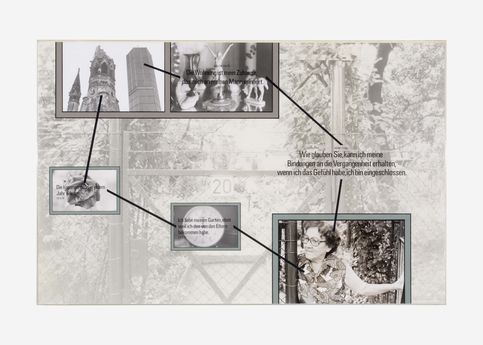Wie ich meine Fluchtwege organisiere

Stephen Willats
Wie ich meine Fluchtwege organisiere, 1979-1980
Collage, 4 parts Computer printouts, photographic prints, gouache, letraset text on cardboard single framed in plexi--glass boxes 82.5 x 128 cm each
GF0031100.00.0-2009
Artwork text
Stephen Willats Organising My Means Of Escape The total encirclement of the individual in an urban ‘new reality’ is complete in West Berlin, unless you have the will to create your own resistance against it. While ‘Schrebergärten’ exist in other cities, in West Berlin they assume a special significance, and their occupation of every spare bit of land is something that inevitably hits the visitor straightaway. Seventy or eighty years seems a long time in modern Berlin, and although some of the gardens are as old as this, a lot are very recent, and the colonies in which they exist seem to be always growing. The gardens, apart from representing an obvious escape into nature and greenery, are a symbolic breaking of West Berlin’s containment, also being the means by which old values and customs are kept alive, and are thus an important context for a fight back against the pressures of modern day Berlin life. The work ‘Organising My Means Of Escape’ looks at the different functions a particular garden has as an agent of escape for its tenant, an elderly lady who has lived all her life in the same district of Berlin. The lady who agreed to co-operate with me in the making of the work, has her garden in a colony at Westkreuz, near Halensee at the end of the Kurfürstendamm. However, the daily existence of the lady, and the physical conditions in which she lives, are a world away from the images portrayed in those famous Kurfürstendamm shop windows. When not in her garden, she resides in a dark, tiny, unaltered room, four stories up in a hinterhouse, at the back of some sex shops on Kaiser-Friedrich-Straße. Everyday, summer and winter, she goes to the garden, a twenty minute walk, to be there at eleven o’clock, and then returns to her small room for six in the evening. In the work well-known symbols from the ‘new Berlin’ are related, and contrasted, with the past fixed in time within the inner world of the lady’s flat. The ever-present pressure these modern symbols exert on the psychological outlook of the old lady are seen in the work as the source of her motivation to escape daily into the garden that is her own island. Here the island is a fortress that preserves the past, enclosing it against the further encroachment of the alien value structure of the ‘new Berlin’ that can be visibly seen when inside the garden. Four functions that the garden has in the lady’s life are defined in the work, each one being the parameter for the internal structure of the four panels that are sequenced as follows: 1. Maintains her links with the past 2. Provides her with a purpose 3. Relieves her isolation 4. An expression of alternative values While the whole garden and all its contents are seen as a manifestation of ‘counter consciousness’, within its delineated space various imported objects and inherent natural elements are pinpointed as having particular significance in agencing the lady’s escape. On one hand objects from the external world have been taken into the garden to agency the private functions it has for her, and on the other natural elements signify a value structure that extends out beyond the urban island in which she is trapped, to a world where ‘nature’ predominates. This conflict between the determinism of the surrounding urban environment and the freedoms assigned to nature—even nature’s culturally given roles are restricted to existing symbolically within the garden—forms the basis for a problem situation in each of the work’s four states. The problem is directed at the viewer as a question; a response to which involves them in entering into the ‘symbolic world’ encoded in the work and building their response by making their own connections between the various disparate references (quotations and photographic images) presented there.




